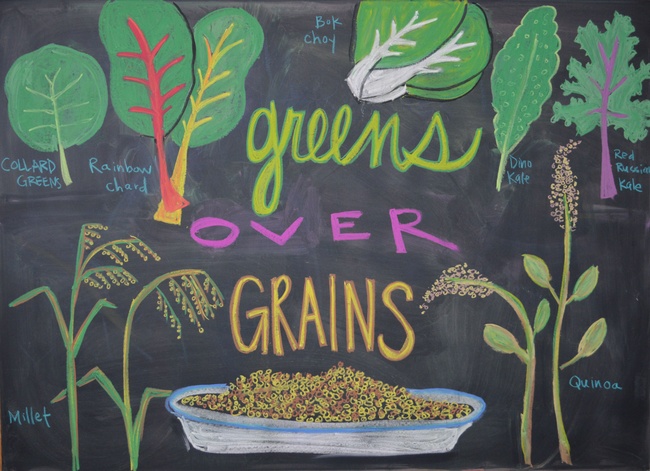Kitchen Humanities: Greens Over Grains

Summary
In this 6th grade humanities lesson, students complete the seed to table cycle by preparing sautéed greens and serving them over grains that have been grown in the Edible Schoolyard garden.
Objectives
After this lesson, students will be able to:
- Identify steps within the seed to table cycle.
- Practice basic knife skills while demonstrating proper knife safety and care
- Articulate the importance of the domestication of plants
Assessments
During this lesson, students will:
- Explain how the seed to table cycle relates to the kitchen, the garden, and the environment.
- Properly mince or slice ingredients as directed
- Describe the process of domesticating plants
Materials
For the Chef Meeting
- Sautéed Greens recipe
- Ingredients and tools for demonstration
- Visual aid
Ingredients
- Millet
- Quinoa
- Barley
For the Sautéed Greens
Assorted greens (Dinosaur kale, bok choi, rainbow chard)
- Olive oil
- Ginger
- Garlic
- Soy sauce
- Toasted sesame oil
- Rice vinegar
Tools
- Cast Iron Skillet
- Garlic peeler
- Wooden spoon
- Chefs’ knives
- Paring knives
- Cutting boards
- Measuring cups
- Measuring spoons
Equipment
Stove
Before You Begin
- Collect all the tools and ingredients, and then distribute them to the tables.
- Gather supplies for the Chef Meeting
- Create the visual aid
- Copy the Sautéed Greens recipe to hand out
- Cook the millet
- Cook the quinoa
- Cook the barley
Procedures
At the Chef Meeting
- Welcome students to the kitchen and introduce the Greens over Grains lesson as a chance to prepare greens from the garden while learning basic knife skills, safety, and care.
- Introduce the Greens over Grains lesson as the completion of the seed to table cycle, then review the Seed to Table lesson from the garden and ask students to explain the seed to table cycle in their own words.
- Ask students to recall the name of the era in which people were hunters and gatherers (Paleolithic), and then have students recall the name of the era in which people began to domestic animals and crops (Neolithic).
- Ask students what it means to domesticate grains. Remind students that the crops people domesticated thousands of years ago still determine what we eat every day.
- Ask students to identify the greens by name.
At the Table
- Meet with the table groups to review the recipe, check in, and assign jobs.
- Describe each step of the recipe, as well as the tools necessary to complete each job.
- Demonstrate mincing, chopping, and slicing, and encourage students to cut with intention.
- Prepare the recipe and set the table.
- Eat.
- Clean up.
At the Closing Circle
- Ask each student to name one new skill or fact that they learned in the class today.
Vocabulary
Sauté
Mince
Slice
Chop
Fibrous
Whole grain